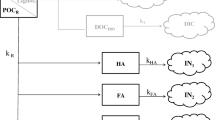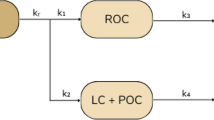Abstract
Purpose
Aquatic macrophytes are an important source of autochthonous dissolved organic carbon in aquatic ecosystems. Yield and mass loss of aquatic humic substances released from macrophytes decomposition could be affected by the plant species and oxygen availability. Our aim was to describe the kinetics of dissolved fulvic and humic acids formed from decomposition of four aquatic macrophytes under aerobic and anaerobic conditions.
Materials and methods
Samples of Eichhornia azurea (Sw.) Kunth, Egeria najas Planch, Oxycaryum cubense (Poepp. and Kunth), and Salvinia molesta (Mitchell) were incubated under aerobic and anaerobic conditions. On sampling days, the remaining particulate detritus were weighted and were measured for the pH, the electrical conductivity, and the organic carbon in the dissolved fraction. Humic substances were extracted from the dissolved fraction, separated into fulvic and humic acids, and then quantified. The mass loss of particulate and dissolved fractions were fitted to first order kinetic models.
Results and discussion
Aerobic environment favored mineralization of aquatic macrophyte detritus and humification of organic dissolved carbon. Incubations under aerobic conditions formed 3.6 times more humic acid than incubations under anaerobic conditions. However, incubations in an anaerobic environment formed 1.84 times more fulvic acid. The dissolved humic compounds presented low mineralization rates probably due to the presence of the macrophyte detritus in the incubation representing a more attractive source of resource for microorganisms.
Conclusions
In many cases, the mineralization of HS was not noticed, leading to an increase in humic and fulvic acid concentration in the water. O. cubense detritus presented the highest carbon concentration, were related to refractory features, and generated the highest amounts of dissolved HA (mainly under aerobic condition). Egeria najas detritus presented the lowest carbon concentration, were related to labile features, and generated the highest amounts of dissolved FA (mainly under anaerobic condition). Besides that, high humic substance concentrations in the dissolved organic carbon were related to low mineralization of this fraction.







Similar content being viewed by others
References
Amon RMW, Benner R (1996) Bacterial utilization of different size classes of dissolved organic matter. Limnol Oceanogr 41:41–51
Anesio AM, Granéli W, Aiken GR, Kieber DJ, Mopper K (2005) Effect of humic substance photodegradation on bacterial growth and respiration in lake water. Appl Environ Microbiol 71:6267–75
Anesio AM, Hollas C, Granéli W, Laybourn-Parry J (2004) Influence of humic substances on bacterial and viral dynamics in freshwaters. Appl Environ Microbiol 70:4848–4854
Attermeyer K, Hornick T, Kayler ZE, Bahr A, Zwirnmann E, Grossart H-P, Premke K (2014) Enhanced bacterial decomposition with increasing addition of autochthonous to allochthonous carbon without any effect on bacterial community composition. Biogeosciences 11:1479–1489
Bano N, Moran M, Hodson R (1998) Photochemical formation of labile organic matter from two components of dissolved organic carbon in a freshwater wetland. Aquat Microb Ecol 16:95–102
Bano N, Moran MA, Hodson RE (1997) Bacterial utilization of dissolved humic substances from a freshwater swamp. Aquat Microb Ecol 12:233–238
Benner R, Moran MA, Hodson RE (1986) Biogeochemical cycling of lignocellulosic carbon in marine and freshwater ecosystems: relative contributions of prokaryotes and eukaryotes. Limnol Ocean 31:89–100
Berg B, Laskowski R (2005) Methods in studies of organic matter decay. Adv Ecol Res 38:291–331
Bianchini I Jr, Da Cunha-Santino MB, Romeiro F, Bitar AL (2010) Emissions of methane and carbon dioxide during anaerobic decomposition of aquatic macrophytes from a tropical lagoon (São Paulo, Brazil). Acta Limnol Bras 22:157–164
Bianchini I Jr, da Cunha-Santino MB, Ribeiro J, Penteado D (2014) Implication of anaerobic and aerobic decomposition of Eichhornia azurea (Sw.) Kunth. on the carbon cycling in a subtropical reservoir. Braz J Biol 74:100–110
Bianchini I Jr, Cunha-Santino MB, Panhota RS (2011) Oxygen uptake from aquatic macrophyte decomposition from Piraju Reservoir (Piraju, SP, Brazil). Braz J Biol 71:27–35
Bottino F, Calijuri MDC, Murphy KJ (2013) Organic matter cycling in a neotropical reservoir: effects of temperature and experimental conditions. Acta Limnol Bras 25:192–201
Chambers PA, Lacoul P, Murphy KJ, Thomaz SM (2008) Global diversity of aquatic macrophytes in freshwater. Hydrobiologia 595:9–26
Cunha MB, Bianchini I Jr (1998) Cinéticas de mineralização aeróbica de celulose e lignina durante a degradação de Cabomba piauhyensis e Scirpus cubensis. Acta Limnol Bras 10:59–69
Cunha-Santino MB, Bianchini I Jr (2008) Humic substances cycling in a tropical oxbow lagoon (São Paulo, Brazil). Org Geochem 39:157–166
Cunha-Santino MB, Bianchini I Jr (2004) Oxygen uptake during mineralization of humic substances from Infernão Lagoon (São Paulo, Brazil). Braz J Biol 64:583–590
Davis ML, Masten SJ (2008) Principles of environmental engineering and science, 2nd edition. McGraw-Hill, New York
Donderski W, Burkowska A (2000) Metabolic activity of heterotrophic bacteria in the presence of humic substances and their fractions. Polish J Environ Stud 9:267–271
Farjalla VF, Amado AM, Suhett AL, Meirelles-Pereira F (2009) DOC removal paradigms in highly humic aquatic ecosystems. Environ Sci Pollut Res 16:531–538
Fischer H, Sachse A, Steinberg CEW, Pusch M (2002) Differential retention and utilization of dissolved organic carbon by bacteria in river sediments. Limnol Oceanogr 47:1702–1711
Gimenes KZ, Cunha-Santino M, Bianchini I (2013) Cellulase activity in anaerobic degradation of aquatic macrophytes tissues. Fundam Appl Limnol 183:27–39
Golterman HL (1975) Physiological limnology: an approach to the physiology of lake ecosystems, 2nd edn. Elsevier Science, Amsterdam
He D, Ruan H (2014) Long term effect of land reclamation from lake on chemical composition of soil organic matter and its mineralization. PLoS One 9:e99251
Hertkorn N, Claus H, Schmitt-Kopplin P, Perdue EM, Filip Z (2002) Utilization and transformation of aquatic humic substances by autochthonous microorganisms. Environ Sci Technol 36:4334–4345
IHSS IHSS (2007) What are humic substances? In: www.humicsubstances.org. http://www.humicsubstances.org/whatarehs.html. Accessed 16 Jun 2015
Ikan R, Dorsey T, Kaplan I (1990) Characterization of natural and synthetic humic substances (melanoidins) by stable carbon and nitrogen isotope measurements and elemental compositions. Anal Chim Acta 232:11–18
Kalantary RR, Badkoubi A (2006) Effect of humic compounds on bacterial growth in bioremediation of pahs. Iran J Environ Health Sci Eng 3:31–38
Klüpfel L, Piepenbrock A, Kappler A, Sander M (2014) Humic substances as fully regenerable electron acceptors in recurrently anoxic environments. Nat Geosci 7:195–200
Köhler SJ, Kothawala D, Futter MN, Liungman O, Tranvik L (2013) In-lake processes offset increased terrestrial inputs of dissolved organic carbon and color to lakes. PLoS One 8:e70598
Kristensen E, Ahmed SI, Devol AH (1995) Aerobic and anaerobic decomposition of organic matter in marine sediment: which is fastest? Limnol Oceanogr 40:1430–1437
Leenheer JA (1981) Comprehensive approach to preparative isolation and fractionation of dissolved organic carbon from natural waters and wastewaters. Environ Sci Technol 15:578–87
Lousier JD, Parkinson D (1976) Litter decomposition in a cool temperate deciduous forest. Can J Bot 54:419–436
Mcdonald S, Bishop A, Prenzler P, Robards K (2004) Analytical chemistry of freshwater humic substances. Anal Chim Acta 527:105–124
Megonigal JP, Hines ME, Visscher PT (2014) Anaerobic metabolism: linkages to trace gases and aerobic processes. Treatise on geochemistry. Elsevier, Amsterdam, pp 273–359
Minderman G (1968) Addition, decomposition and accumulation of organic matter in forests. J Ecol 56:355
Nunes MF, da Cunha-Santino MB, Bianchini I Jr (2011) Xylanase and cellulase activities during anaerobic decomposition of three aquatic acrophytes. Braz J Microbiol 42:75–83
O’Connell M, Baldwin DS, Robertson AI, Rees G (2000) Release and bioavailability of dissolved organic matter from floodplain litter: influence of origin and oxygen levels. Freshw Biol 45:333–342
Park S, Cho K (2003) Nutrient leaching from leaf litter of emergent macrophyte (Zizania latifolia) and the effects of water temperature on the leaching process. Korean J Biol Sci 7:289–294
Passerini MD, Cunha-Santino MB, Bianchini I (2016) Oxygen availability and temperature as driving forces for decomposition of aquatic macrophytes. Aquat Bot 130:1–10
Piccolo A (2001) The supramolecular structure of humic substances. Soil Sci 166:810–832
Pires AMZCR, Santos JE, Pires JSR (2000) Caracterização e diagnóstico ambiental de uma unidade de paisagem. In: Santos JE, Pires JSR (eds) Estudo de caso: Estação ecológica do Jataí e estação experimental de Luiz Antônio, 1st edn, Estud. Integr. em ecossistemas - Estação Ecológica Jataí. RiMa, São Carlos, pp 1–26
Press WH, Teukolsky SA, Vetterling WT, Flannery BP (2007) Numerical recipes 3rd Edition: the art of scientific computing, 3rd edn. Cambridge University Press, Cambridge
Qualls RG, Richardson CJ (2000) Phosphorus enrichment affects litter decomposition, immobilization, and soil microbial phosphorus in wetland mesocosms. Soil Sci Soc Am J 64:799
Qualls RG, Richardson CJ (2003) Factors controlling concentration, export, and decomposition of dissolved organic nutrients in the Everglades of Florida. Biogeochemistry 62:197–229
Rocha O, Espindola ELG, Rietzler AC, Santos-Wisniewski M (2000) Diversidade do zooplâncton nas lagoas marginais do rio Mogi-Guaçu: III. Copepoda (Crustacea). In: Santos JE, Pires JSR (eds) Estud. Integr. em ecossistemas - Estação Ecológica Jataí, 2nd edn. RiMa, São Carlos, pp 587–598
Sciessere L (2011) Ação das enzimas extracelulares na dinâmica da decomposição de macrófitas aquáticas
Sciessere L, Cunha-Santino MB, Bianchini I Jr (2011) Cellulase and xylanase activity during the decomposition of three aquatic macrophytes in a tropical oxbow lagoon. Braz J Microbiol 42:909–918
Silva DS, Cunha-Santino MB, Marques EE, Bianchini I Jr (2011) The decomposition of aquatic macrophytes: bioassays versus in situ experiments. Hydrobiologia 665:219–227
Smith RL, Smith TM (2001) Ecology and field biology: hands-on field package, 6th edn. Benjamin Cummings, New York
Song N, Cai H-Y, Yan Z-S, Jiang H-L (2013) Cellulose degradation by one mesophilic strain Caulobacter sp. FMC1 under both aerobic and anaerobic conditions. Bioresour Technol 131:281–287
Steinberg CEW (2003) Ecology of humic substances in freshwaters: determinants from geochemistry to ecological niches. Springer, Berlin
Stevenson FJ (1995) Humus chemistry: genesis, composition, reactions, Second Edition, Wiley. J Chem Educ. doi: 10.1021/ed072pA93.6, ISBN: 978-0-471-59474-1, 512 pp
Stripari NL, Henry R (2002) The invertebrate colonization during decomposition of Eichhornia azurea Kunth in a lateral lake in the mouth zone of Paranapanema River into Jurumirim Reservoir (São Paulo, Brazil). Braz J Biol 62:293–310
Thurman EM (1985) Organic geochemistry of natural waters. Springer Netherlands, Dordrecht, p 497. doi:10.1007/978-94-009-5095-5
Thurman EM, Malcolm RL (1981) Preparative isolation of aquatic humic substances. Environ Sci Technol 15:463–466
Tranvik LJ (1988) Availability of dissolved organic carbon for planktonic bacteria in oligotrophic lakes of differing humic content. Microb Ecol 16:311–322
Wetzel RG (1995) Death, detritus, and energy flow in aquatic ecosystems. Freshw Biol 33:83–89
Wisniewski MJS, Rocha O, Rietzler AC (2000) Diversidade do zooplõncton nas lagoas marginais do rio Mogi-Guacu: II Cladocera (Crustacea, Branchiopoda). In: Santos JE, Pires JSR (eds) Estud. Integr. em ecossistemas – Estação Ecológica Jataí, 2nd edn. RiMa, São Carlos, pp 559–586
Wurzbacher C, Bärlocher F, Grossart H (2010) Fungi in lake ecosystems. Aquat Microb Ecol 59:125–149
Zsolnay Á (2003) Dissolved organic matter: artefacts, definitions, and functions. Geoderma 113:187–209
Acknowledgments
This study was conducted in the Laboratório de Bioensaios e Modelagem Matemática of the Universidade Federal de São Carlos—UFSCar and funded by the Fundação de Amparo à Pesquisa do Estado de São Paulo—FAPESP (processes: 11/16990-4 and 11/10178-6).
Author information
Authors and Affiliations
Corresponding author
Additional information
Responsible editor: Fernando Rosario-Ortiz
Rights and permissions
About this article
Cite this article
Assunção, A.W.d.A., Souza, B.P., da Cunha-Santino, M.B. et al. Formation and mineralization kinetics of dissolved humic substances from aquatic macrophytes decomposition. J Soils Sediments 18, 1252–1264 (2018). https://doi.org/10.1007/s11368-016-1519-x
Received:
Accepted:
Published:
Issue Date:
DOI: https://doi.org/10.1007/s11368-016-1519-x




